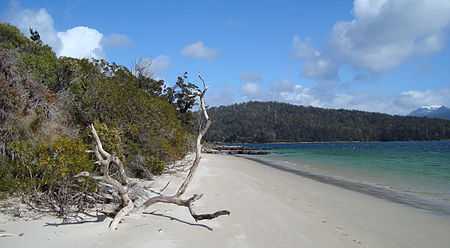Recherche Bay

Recherche Bay is on the extreme south-eastern corner of Tasmania, Australia. It was a landing place of the d’Entrecasteaux expedition to find missing explorer La Pérouse. It is named after the Recherche, one of the expedition's ships.
French exploration
The explorers set up a camp, made a garden and scientific observatory at Recherche Bay in April 1792 for 26 days, and again in January 1793 for 24 days. Both landings were made to seek refuge and replenish supplies although as much time as possible was dedicated to scientific research. The botanists Jacques Labillardière, Claude Riche and Étienne Pierre Ventenat, assisted by gardener botanist Félix Delahaye, collected and catalogued almost 5000 specimens including the blue gum (Eucalyptus globulus), which later became Tasmania's floral emblem. The expedition also made friendly contact with the Tasmanian Aboriginal people there in 1793.
The scientific observatory at Recherche Bay was the site of the first deliberate scientific experiment on Australian soil. At this observatory, geoscientist Elisabeth Paul Edouard de Rossel conducted a series of measurements that proved geomagnetism varied with latitude.
British settlement
Being isolated from the main areas of early settlement, exposed to easterly gales, and the terrain and soils of a nature that discouraged European agriculture, Recherche Bay saw only moderate activity following the British settlement of Van Diemen's Land. During the 1830s and 1840s it was the site of a bay whaling station as well as a base for pilots guiding ships up the D'Entrecasteaux Channel. Whaling ships occasionally sheltered there to try out whales, two (the Maria Orr in 1846 and Offley in 1880) being wrecked there in gales. The main commercial activities in the later 19th century and into the early 20th century were timber-gathering, mostly centred on the township of Leprena and coal mining, the latter mostly based around the township of Catamaran. The Catamaran Coal Company employed the former barque James Craig as a coal hulk there.
Recent controversy
In 2003, the private landowners of the D'Entrecasteaux expedition site sought permission to selectively log the area resulting in a large-scale campaign to protect the site from destruction.
In January 2006, the Tasmanian Land Conservancy (TLC) announced plans to raise a minimum of $1.3 million to purchase the site from its private owners. High profile businessman Dick Smith pledged A$100,000 to the cause. Two weeks later, it was announced that over $2 million had been raised to purchase and rehabilitate the site, and that it would be owned by TLC.
See also
Quotes
It will be difficult to describe my feelings at the sight of this solitary harbour situateted at the extremeties of the globe, so perfectly enclosed that one feels separated from the rest of the universe. Everything is influenced by the wilderness of the rugged landscape. With each step, one encounters the beauties of unspoilt nature, with signs of decrepitude, trees reaching a very great height, and of corresponding diameter, are devoid of branches along the trunk, but crowned with an everlasting green foliage. Some of these trees seem as ancient as the world, and are so tightly interlaced that they are impenetrable.
Bruni d'Entrecasteaux, Recherche Bay, January 1793 [1]
References
- ^ National Trust Endangered Places 2003 accessed on 5 January 2006.
- ^ Australian National Heritage listing for Recherche Bay accessed on 9 July 2008.
- ^ Bid to Buy Recherche accessed on 20 January 2006.
- ^ Dick Smith joins bid to protect Recherche Bay, ABC News, 23 January 2006. Accessed on 24 January 2006.
- ^ Recherche Bay saved from logging, ABC News, 8 February 2006. Accessed 11 July 2010.
- ↑ Richard Landsdown, Romantic aftermaths, p. 120 in: Peter Pierce (ed.), The Cambridge History of Australian Literature, Port Melbourne: Cambridge University Press 2009. ISBN 978-0-521-88165-4
Further reading
- Bob Brown, Tasmania’s Recherche Bay, Published by Green Institute, GPO Box 927, Hobart, Tasmania, 7001, 2005, pp. 56, illustrations, maps, ISBN 0-646-44899-4
- Edward Duyker & Maryse Duyker (ed. & trans) Bruny d’Entrecasteaux: Voyage to Australia and the Pacific 1791—1793, Miegunyah/Melbourne University Press, Melbourne, 2001, pp. xliii, pp. 392, ISBN 0-522-84932-6 [paperback edition, March 2006, ISBN 0-522-85232-7]
- Edward Duyker, Citizen Labillardière: A Naturalist’s Life in Revolution and Exploration (1755–1834), Miegunyah/MUP, Melbourne, 2003, ISBN 0-522-85010-3, Paperback reprint, 2004, pp. 383, ISBN 0-522-85160-6, [Winner, NSW Premier’s General History Prize, 2004].
- Edward Duyker,‘A French Garden in Tasmania: The Legacy of Félix Delahaye (1767—1829)’, Explorations, December 2004 (issued October 2005), pp. 3–18.
- Edward Duyker, ‘Uncovering Jean Piron: In Search of d’Entrecasteaux’s Artist’, Explorations, December 2005 (issued June 2006), pp. 37–45.
- John Mulvaney & Hugh Tyndale-Biscoe (eds.), Rediscovering Recherche Bay, Academy of the Social Sciences in Australia, Canberra, December 2007, ISBN 978-0-908290-22-2, paperback, pp. 156,
- John Mulvaney, The axe had never sounded’: Place, People and Heritage of Recherche Bay, Tasmania, ANU E Press and Aboriginal History, Canberra, 2007, ISBN 978-1-921313-20-2 (pbk.).
- Bruce Poulson, Recherche Bay: A Short History, Published by the Management Committee of the Southport Community Centre, Main Road, Southport, 7109, second edition 2005, pp. 83, illustrations, bibliography, maps, ISBN 09757950-6
- Danielle Clode, Voyages to the South Seas: In search of Terres Australes, Miegunyah/MUP, Melbourne, 2007, ISBN 0-522-85264-5, Paperback reprint, 2008, ISBN 0-522-85542-3, [Winner, The Nettie Palmer Prize for Non-fiction, 2007].